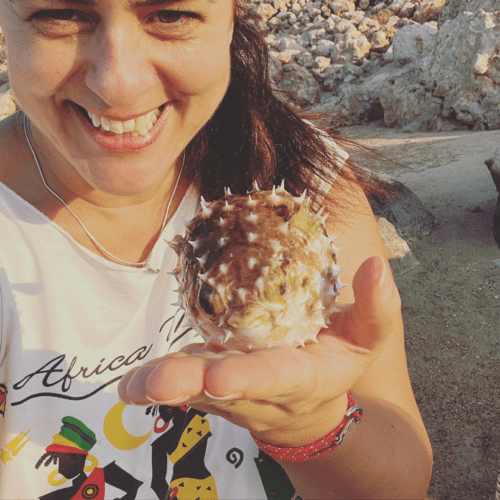 Guppies are one of the most popular freshwater aquarium fish species and it’s not difficult to see why. Not only are they beautiful to look at, they are also quite easy to keep as pets. There are some signs of distress to look out for, though, including your guppies staying at the top of the tank.
Guppies are one of the most popular freshwater aquarium fish species and it’s not difficult to see why. Not only are they beautiful to look at, they are also quite easy to keep as pets. There are some signs of distress to look out for, though, including your guppies staying at the top of the tank.
Table of Contents
Why Are My Guppies Staying At The Top Of The Tank?
If your guppies stay at the top of the tank, you need to act immediately, as there are various reasons why they show this behavior. Reasons include a lack of oxygen, water that is the wrong pH, wrong temperature, or contain high levels of ammonia and/or nitrites and nitrates. These can all harm or even kill your fish.
There are some steps that you can take to get the tank’s water at the correct levels for your guppies. Some of these steps are quite involved but can save your guppies’ lives. We’re going to look at how to solve all these problems one by one.
The first step you should take before starting one or more of the steps below is to test the water for:
- Oxygen
- Temperature
- pH
- Ammonia
- Nitrites/nitrates
How To Treat A Lack Of Oxygen In A Tank With Guppies
Guppies breathe oxygen which is dissolved in the water and the level of oxygen is higher closer to the surface of the tank. However, you might also notice that your guppies linger close to air stones or any bubble-producing décor that you may have in the tank.
If this is the case, there may be various reasons why there is a lack of oxygen in the water. These include:
- Overpopulation
- No air stone or device that delivers air (and therefore oxygen) to the tank water
- Lack of surface area
Let’s look at each of these in turn.
Overpopulation And Overcrowding
Even though guppies are quite small fish, you shouldn’t make the mistake of getting a tank that is too small for your fish. Rather get a tank that is too big than too small. (Otherwise your fish will start to feel like you do when stuck in an elevator full of people!)
You should have at least one gallon of water per one inch of adult fish when it comes to freshwater fish like guppies. For example, don’t go smaller than a fifteen-gallon aquarium for your guppies if you have 4 or 5 guppies.
We explain in detail how many guppies you should have in your tank and what might happen if you have too many guppies in this article – Read it here!
No Air Stone Or Device That Aerates The Water
Because your aquarium is not the same environment of moving water than the natural environment of guppies are, you need to ensure that the water is artificially moved and aerated. This is why filters, elements like air stones and even bubble producing décor is so important.
Lack Of Surface Area
When choosing which aquarium you’re going to get for your guppies, it’s important not to choose the tank simply for its volume, but for its surface area (that is to say, one where more of the water have contact with the air).
This will ensure that the tank has higher oxygen levels because there is more water surface where the oxygen can dissolve into the water.
How to Treat Water That Is The Wrong Temperature
The temperature of the water in your aquarium also has an influence on the amount of oxygen that’s dissolved in the water.
Warm water holds less oxygen than cold water does, so it’s important to keep an eye on the water temperature during summer and winter (as you also don’t want to keep your guppies in frigid water!).
You can quite easily remedy the temperature of the water by adding a fish tank heater or chiller to the aquarium to keep the water at a temperature of 75-82 F.
It’s important not to add cold or warm water to the tank to correct the temperature as you can shock your guppies with the sudden temperature change.
How To Treat Water That Has The Wrong pH In A Tank With Guppies
The ideal pH for the water in your guppies’ aquarium is 7.0-7.2. However, guppies can tolerate a pH of 5.5-8.5. Be careful not to change the pH of the water too quickly, however, as this can also shock your fish.
When you bring your fish home or switch them from one aquarium to another, you need to match the pH as closely as possible to ensure that you don’t shock the fish with a significant change in pH.
If you test the water in your aquarium and find that the pH is very wrong, you can make changes to the pH. If your water tests as 6.8, for example, you need not make any changes and only keep an eye on the pH.
How To Change The pH of the Aquarium’s Water
However, if there are big changes in the pH when you measure it every two weeks or so, you will need to find out what the source of the imbalance is. You will also need to intervene if your guppies are in distress.
The water’s pH will change when you do partial water changes (30-50% of the water) at frequent intervals. You can also vacuum the gravel and check that your biological filter is working correctly to keep acidity in check.
Commercial Products
Pet stores sell certain commercial products to change water’s pH, but it’s best to first try changing some of the water or vacuuming the gravel — especially if you are new to keeping guppies and are not used to working with the different chemicals.
How To Treat High Levels Of Ammonia and Nitrites In A Tank With Guppies
Guppies, like other fish, can get poisoned by high levels of ammonia and nitrites. If you test your aquarium’s water and find that there are high levels of ammonia and nitrites in the water, you will also need to make certain changes to lower these levels.
Ammonia Poisoning
High levels of ammonia can actually burn the fish and can cause their gills to swell. When this happens, they will swim to the surface of the water and look as if they are gasping for air.
Red spots can also appear on your guppy’s body – this is actually blood and shows that you need to act very quickly so as not to lose your fish.
Adding Fish To The Aquarium
Ammonia levels can rise quite suddenly if you add more fish (guppies or their tank mates) to the aquarium.
When you do plan on adding more fish to the aquarium, it’s imperative that you make sure that you not only acclimatize the new fish to the water temperature, etc. but also don’t add a bunch of ammonia or nitrites to the water when you add them.
It’s therefore very important to test the water in your aquarium before and after adding fish.
A New Aquarium
If it’s a new aquarium, you will also need to “cycle” the tank before adding the fish. This is to ensure that the bacteria that is necessary for the nitrogen cycle is present in the levels they should be and that the ammonia levels and pH of the water is at the correct levels for your guppies.
Lowering The Levels Of Ammonia In The Tank’s Water
In order to lower the tank’s ammonia levels, you will need to change some of the water in the tank, replacing it with de-chlorinated water that contains no ammonia. This will ensure that you lower the water without hurting your fish.
Depending on the ammonia levels, you will need to change up to 75% of the water (in acute circumstances when your guppies are in obvious distress or is showing signs of poisoning), although usually changing 30-50% of the water should do the trick.
Be sure to test the water consistently to ensure that the levels of ammonia and nitrates/nitrites even out and stay consistent and at the right levels.
Making Sure That Your Guppies Aren’t Sick
Finally, if you see that, after testing the tank’s water and correcting the different levels, your guppies’ behavior doesn’t return to normal — which can take a few hours — you will need to figure out if they may be sick.
These are different signs of distress or illness that you can look out for:
- Still gasping at the air or swimming at the top of the tank (can be a sign of swollen gills)
- Keeping their fins close to their bodies, not moving them as they usually do
- Seeming to float at the top of the tank (but still breathing, even gasping, with a distended body, your fish could be suffering from dropsy. Dropsy can be prevented to a large extent by keeping the aquariums water at the correct levels and by feeding your guppies quality food
- White spots on their body (called Ich)
- “Yellow dust” on their body (called Velvet)
- Fins that look torn (caused by fungus)
As you can see, there are a lot of different reasons why your guppies may be staying at the top of the tank, however, by educating yourself as much as possible, you can ensure that your guppies stay happy and healthy.

Marta, the driving force behind WaterWorldCraze.com, holds a Master’s degree in Marine Biology and has extensive experience in water sports and activities. With over 7+ years of hands-on experience in marine research and conservation, she has participated in numerous underwater expeditions and projects. Her passion for the aquatic world shines through in her expertly curated content. Join Marta as she explores the wonders of marine life and shares her adventures. Connect with her on Instagram @marinebiologymarta for more insights and updates.

